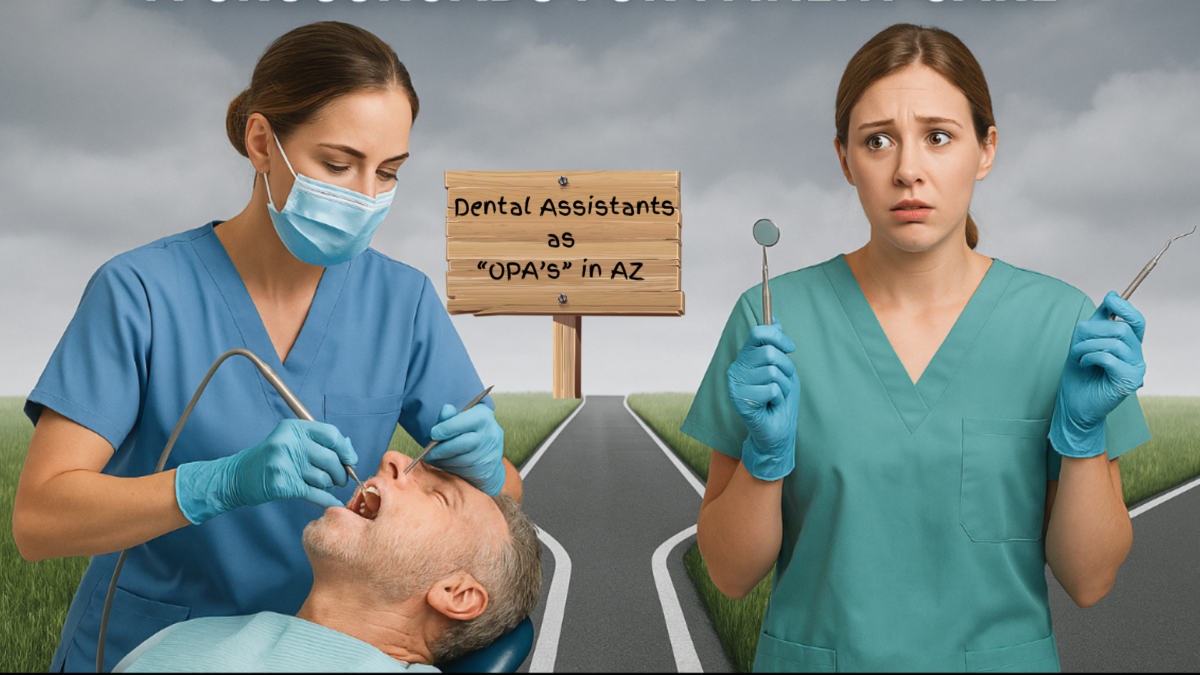The dental hygiene profession in Arizona is at a crossroads. With the recent introduction of Arizona Senate Bill 1124, significant changes are on the horizon that could reshape the landscape of preventive dental care. If you’re a dental hygienist, dentist, or practice owner, understanding the full impact of this bill is not just important—it’s urgent.
The Growing Crisis in Dental Hygiene
For years, dental hygienists have voiced concerns over feeling underappreciated, undervalued, and for some, underpaid . Many have experienced burnout, a lack of career growth opportunities for autonomy in the profession, and the frustration of seeing their expertise
sidelined and undervalued. The aftermath of the pandemic only intensified this crisis, with many hygienists opting not to return to the workforce.
On top of this, standards of care have suffered in some practices due to a lack of commitment to continuing education, lack of overall hard and soft tissue assessments, inadequate periodontal probing, and insufficient disease assessment. These issues have not gone unnoticed, leading lawmakers to take action.
What is Arizona Senate Bill 1124?
Senate Bill 1124 introduces a new role in the dental industry: the Oral Preventative Assistant (OPA). This proposed position is designed to provide basic preventive care services, taking over some of the duties traditionally performed by Registered Dental Hygienists (RDHs).
The bill was proposed in response to a shortage of available dental care providers, rising costs, and a push for more affordable and accessible oral healthcare. While the goal of increasing patient access is commendable, the introduction of OPAs raises serious questions about the future of the dental hygiene profession.
See full information here: https://fastdemocracy.com/bill-search/az/57th-1st-regular/bills/AZB00018421/
The Key Differences: RDH vs. OPA
Registered Dental Hygienist (RDH)
●Education & Training: Requires an associate’s or bachelor’s degree in dental hygiene, passing of national and state board exams, CODA accredited education, and continuing education.
●Clinical Expertise: Trained to assess medical histories, hard tissues, identify hard and soft tissue pathologies, and diagnose periodontal disease, perform deep cleanings (scaling and root planing), apply advanced therapies like laser bacterial reduction,
minimally invasive techniques to conserve tooth structure and educate patients on comprehensive oral health behaviors to conduct risk assessments and evaluate social determinants of health. * all of these can be found the newly updated Standards for Clinical practice. www.adha.org/education-resources/standards/
●Tactical & Technical Skills: Advanced skills in hard and soft tissue assessments, airway assessments, periodontal assessment, radiographic interpretation, anesthesia administration, soft tissue management, health promotional coaching, and disease prevention.
Oral Preventative Assistant (OPA)
●Education & Training: Requires a certification program, likely shorter and less rigorous than an RDH program.
●Clinical Role: Performs limited preventive tasks such as coronal polishing, fluoride application, and possibly sealant placement under supervision.
●Limitations: OPAs do not diagnose or treat periodontal disease, perform deep cleanings, or provide advanced patient education. The OPA is an Unlicensed provider, if harm is done, the supervising RDH and DDS are responsible. The practice of supragingival scaling is not supported by any research. Since most patients present with some form of disease at some level, does this mean the assessments will occur at a previous appointment? Also, there is no CDT coding for supragingival scaling. To use the current coding would be fraudulent.
Who Benefits from OPAs?
Senate Bill 1124 aims to lower costs and improve access to preventive care in certain settings, such as:
Large, high-volume corporate dental chains looking for cost-effective staffing solutions. Practices focused primarily on pediatric or routine preventive care where deep cleanings are less common.
Dentists struggling with staffing shortages who need additional support in non-complex cases. However, while OPAs may ease workflow challenges, they do not replace the critical role of a skilled RDH in assessing, and diagnosing craniofacial abnormalities, airway assessments, minimally invasive techniques, and treating periodontal disease.
Should RDHs Be Worried About Job Security?
While the introduction of OPAs might seem like a direct threat to RDH positions, the reality is more nuanced. High-quality dental practices that prioritize clinical excellence will continue to value RDHs over OPAs. Why? Because advanced providers deliver superior patient care, directly influencing case acceptance, patient trust, and business growth.
A Harvard Business Review study found that businesses investing in highly skilled professionals outperform those relying on lower-skilled labor. In dentistry, this translates to better patient outcomes, stronger patient retention, and increased profitability.
Challenges of Transitioning to a Lower-Skilled Workforce
Dental offices considering OPAs must prepare for:
●Training & Workflow Integration: OPAs will need significant training to align with practice standards.
●Patient Perception & Retention: Patients expect knowledgeable, experienced providers—downgrading provider skill level could impact trust.
●Administrative & Insurance Challenges: Billing and coding for OPAs’ services may require policy adjustments and may not be covered at the same rates as RDH-provided care. There is currently no coding for supragingival scaling
●Return on Investment (ROI): While OPAs may seem cost-effective, they lack the revenue-driving capabilities of RDHs, who contribute to treatment plan acceptance and long-term patient loyalty.
The Value of Clinical Excellence: Why RDHs Remain Essential
RDHs bring a level of expertise, patient education, and comprehensive care that OPAs simply cannot match. Beyond performing cleanings, RDHs play a pivotal role in:
Early disease detection that prevents costly restorative procedures. Advanced therapies that improve patient outcomes and increase practice profitability. Building patient relationships that drive retention and referrals.
What This Means for Dental Professionals
For dental hygienists, now is the time to double down on clinical excellence. Specializing in advanced techniques,craniofacial evaluations, airway assessments, laser therapies, minimally invasive techniques to salvage tooth structure, and comprehensive periodontal care cements your value in the industry. If you’re a dental practice owner, consider whether lowering skill levels in your hygiene department aligns with your long-term goals for patient care and business growth.
Arizona Senate Bill 1124 presents both a challenge and an opportunity. The choice remains: will dental practices prioritize cost-cutting, or will they invest in skilled professionals who drive success? The future of dental hygiene depends on how we answer that question today.



